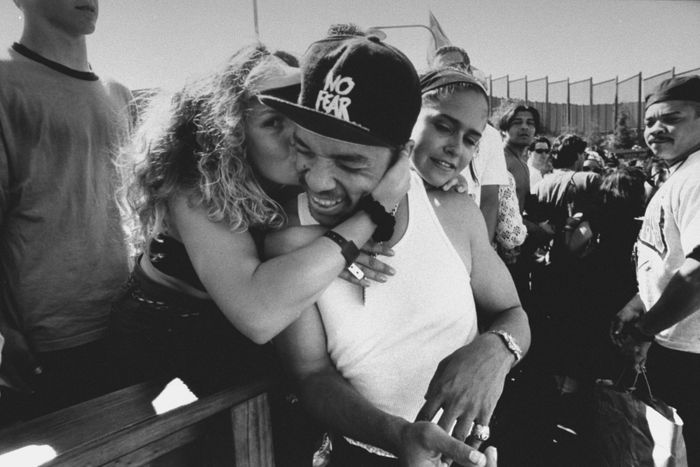
The early lineups of Lollapalooza helped coalesce alternative rock into a powerhouse genre in the 1990s, centered around bands like Jane’s Addiction, Red Hot Chili Peppers, and Pearl Jam. But the most alternative thing the first Lollapalooza did was book a rapper. Ice-T was the clear outlier on the inaugural lineup in 1991, though he had an ace up his sleeve: He was now in a band, too. Ice used half his set to debut his new metal outfit Body Count, which he’d recently formed with guitarist Ernie C. Just months before, Americans had watched a video of Los Angeles police violently beating Rodney King. Now, crowds of white kids were thrashing to Body Count songs like “There Goes the Neighborhood” and “Cop Killer.” In the new Paramount+ docuseries Lolla: The Story of Lollapalooza, Ice-T remembers having a simple realization about the audience during his performance: “They’re with this.”
Like recent music documentaries, Lolla is a mostly hagiographic ’90s nostalgia trip that leans hard on Lollapalooza’s radical roots before valorizing an events-management company for milking the festival’s name for all it’s worth. The series does one remarkable thing, though: It refuses to whitewash the festival’s history, giving credit to the Black artists who helped establish Lollapalooza and alternative rock as a whole.
It wasn’t just Ice-T. The first Lollapalooza lineup, which had been put together as a farewell tour for Jane’s Addiction, featured the rock band Living Colour and fusion act Fishbone. Ice Cube played in 1992 once Ice-T convinced him to jump on, and the festival continued to book hip-hop acts at a steady clip in its early years, including A Tribe Called Quest, Arrested Development, Cypress Hill, and Snoop Dogg. After Tom Morello watched Body Count in 1991, his multiracial rap-rock outfit Rage Against the Machine joined the 1992 and 1993 lineups.
Lollapalooza wasn’t the only rock festival in the early ’90s booking Black artists. Public Enemy headlined England’s longest-running fest, Reading & Leeds — which served as an early model for Lollapalooza — in 1992. But Perry Farrell’s event was happening under the backdrop of American racism. The Rodney King beating hangs over Lolla’s first two episodes, which trace the early to mid-’90s years, as a key factor in the dejection that drove a young Generation X toward alternative music and Lollapalooza in the first place. “America was freakin’ bleak,” remembers Tim Donnelly, an activist who manned a booth for the environmentalist Surfrider Foundation at Lollapalooza ’91. It’s easy to minimize the anger that rooted alternative rock, to write off crowds of kids chanting “Fuck the police!” as loose cannons. But Lolla director Michael John Warren understands there was something deeper at play and tries to unearth it.
The series also contextualizes the earliest years of the festival amid alternative rock’s larger fight against Tipper Gore’s Parents Music Resource Center, which attempted to censor “Cop Killer” after Body Count released its debut album in March 1992. Ice-T lauds Soundgarden for picking up the mantle and covering the song at Lollapalooza ’92; later, John Warren touches on Rage’s infamous nude protest of the PMRC at the ‘93 event. In Lolla’s telling, this was a uniting moment for alt rock, around an issue that most loudly affected Black music.
Lolla even reckons with one of the festival’s clumsiest moments. Toward the end of the 1991 tour, Farrell decided to duet with Ice-T on Sly and the Family Stone’s “Don’t Call Me N- - - - -, Whitey.” The performance is an obvious relic of the early ’90s. But rather than quickly writing it off, John Warren sits with the moment. It’s jarring to hear a long bleep when Farrell sings a racial slur, and it’s equally jarring to hear Ice-T stand by it decades later. “You got the hardest Black band out there and you got him and we’re showing unity,” he says in the doc. “Sometimes that’s how it works, you know. I can’t bring us together with ‘Love your mother, hug your children’ — you gotta catch ’em with the shock value and then hit ’em with the love.”
That, however, is where Lolla’s accounting of its early sins stops. Some of the artists who played Lollapalooza ’92 were disappointed that Ice Cube was the lone Black musician on the lineup. “It smacks of fucking tokenism,” the Jesus and Mary Chain’s Jim Reid told Rolling Stone at the time. But that disappointment isn’t reflected in the series, which simply praises Ice Cube’s decision to play for rock crowds. And the inherent sexism of the festival’s early lineups, which frequently only included a single woman-fronted act, is an afterthought in the series. Though critic Jessica Hopper credits the women who helped build alternative rock, there’s little exploration into why the festival was so dude-forward. Lolla is simply content with Donita Sparks laughing off how her group, L7, one of alternative rock’s most influential lineups of women, had to beg to be on the 1994 lineup, without further wondering why.
Lolla was co-produced by C3 Presents, the promoter that bought the festival’s name in 2014 and brought it to Chicago, so it’s obvious why the series occasionally pulls its punches. While it’s not exactly selfless for Lolla to lionize itself, in a series they helped make, touting both the good and awkward moments that occurred early on still feels unexpected in a music-doc landscape prone to shunning history in favor of only the most positive marketing opportunities. Yes, touting Lollapalooza’s early bona fides benefits Lollapalooza, but underneath that, Lolla is slyly challenging the flattened image of alternative rock in the 1990s. It’s like Farrell’s dream for the first Lollapalooza: Viewers coming for fun could actually learn something.


